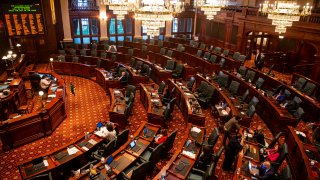
Illinois Democrats were poised Tuesday to approve new legislative boundaries over objections from Republicans and some community groups that the process was unnecessarily rushed and maps were drawn behind closed doors to keep Democrats in power in the state Legislature.
Tuesday's vote is a do-over of legislative maps that majority Democrats approved and Gov. J.B. Pritzker signed earlier this year. Those maps prompted lawsuits from top Illinois Republicans and the Mexican American Legal Defense and Educational Fund, a Latino civil rights organization, who argued that the maps were flawed and unconstitutional because they were based on population estimates from the American Community Survey rather than the 2020 census.
With the release of census data in August, Democratic leaders said the legislative maps would be adjusted and the Legislature would return to Springfield for another vote. That could ensure Democrats continue to control the map-making process, rather than risk having a judge throw out the maps or allow a bipartisan commission to take over the job — a process that could end with Republicans having the final say.
The new maps, which House and Senate Democrats posted online for the first time Monday afternoon, will be used in state legislative elections for the next decade.
Feeling out of the loop? We'll catch you up on the Chicago news you need to know. Sign up for the weekly Chicago Catch-Up newsletter here.
Illinois Democrats have not yet voted on new congressional district boundaries, but with the state losing a congressional seat due to population loss, they are expected to eliminate a GOP-held district and try to make other districts more friendly to Democrats. Illinois is one of the few states where Democrats fully control the redistricting process, and it will play a key role in Democrats' efforts to keep the U.S. House majority next year. The party's approach to state legislative map-making — barreling ahead even amid opposition from typical allies — suggests they will be equally aggressive with congressional boundaries.
Rep. Elizabeth Hernandez, a Democrat from Cicero who leads the House Redistricting Committee, said Monday that the new legislative boundaries “better reflect the data we recently received from the U.S. Census and ensure communities are represented by the people of their choice.”
Republicans have blasted Democrats, saying hastily called and sparsely attended public hearings held over the past week were a sham because boundaries were already being drawn in a secret, Democrat-controlled process.
Local
Witnesses who testified at those hearings urged Democrats to post proposed maps and give the public as much as 30 days — or more — to weigh in before a vote is taken.
Ami Ghandi, senior counsel for the Chicago Lawyers' Committee for Civil Rights, told members of the redistricting committees that it was “unreasonable" to expect voters to provide input without maps to react to. The Rev. Robin Hood, representing Black voters in Chicago, said people felt “disgust” at being left out of the process.
Jay Young, executive director of Common Cause Illinois, said the maps the Legislature will vote on Tuesday "will not be crafted of public input, but of pure politics.”
“At each opportunity in this redistricting process, it’s as if lawmakers went out of their way to ensure the creation of these maps had as little public input as possible," Young said.
Legislators have historically used census data for redistricting, or the process of redrawing political maps every 10 years to reflect changes in population and ensure, among other things, that districts are roughly equal in population. But with the release of 2020 census data delayed this year because of the pandemic, Democrats opted to use the American Community Survey to meet a June 30 deadline set in the state constitution.
If the Legislature didn't meet that deadline, an eight-member commission would be created with an equal number of Democrat and GOP lawmakers. If that group were unable to approve a map, a ninth member would be picked at random to break the tie.
Republicans are hoping that a federal judge will throw out Democrats' maps and order that process begin.
The Illinois Constitution doesn’t set a deadline for congressional district maps to be approved, so legislators opted to wait for the census data before drawing those maps.



